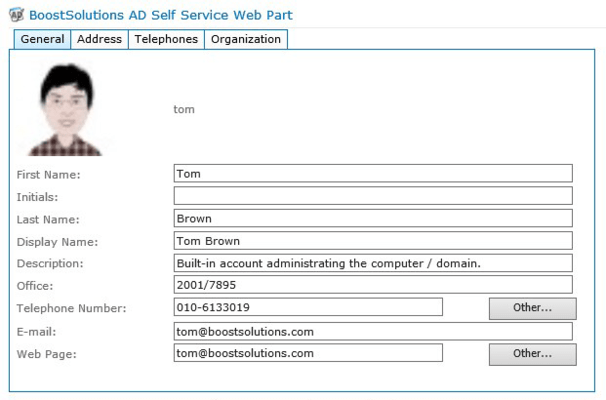SharePoint AD Self Service
The SharePoint AD Self Service web part allows users to modify their personal Active Directory account information in an easy to use, user-friendly SharePoint web part. By default, SharePoint users' profiles are stored and can only be managed in Active Directory. Except for IT administrators and members of Domain Admins, most users are unable to access Active Directory information, nor can they change their own AD properties. The SharePoint AD Self Service web part alleviates this burden on IT administrators by enabling individual users to maintain their own AD information in an intuitive interface. This allows IT administrators to focus on high-priority projects rather than account maintenance.
As an AJAX web part, SharePoint AD Self Service provides users with enjoyable using experience by enabling them to bypass annoying post backs and complete the modification easily. To make changes to their AD properties, all users need to do is type in the user name and password to enter the page where the AD Self Service web part has been added. The web part will automatically detect current login user and domain, retrieving his/her information from AD and display them in the web part. Then, users can start to modify. Finally, by clicking "save", the whole process is complete.
IT administrators have complete control over which properties may be changed and by whom. IT administrators and domain admin members can configure settings in SharePoint Central Administration to restrict and exclude users from changing properties, as well as limiting the properties that are accessible in the web part itself. Equally critical, IT administrators are provided with the options of receiving email notifications or enabling log files to track any AD property change or change attempt, which streamlines the business process of protection-driven organizations.
Members of Domain Admins are able to manage every single tab and property in the AD Self Service web part. They can delete an existing tab or property, and change the display name or add a new one in the web part according to specific requirements. In addition, Domain Admins are also allowed to configure an AD property as editable, read-only, or hide the property completely. Furthermore, the appearance of AD properties is customizable as well. There are three types of appearance to choose from, from a simple text box for custom entries, to a dropdown list (which can either be populated manually by the administrator or looked up from another SharePoint list). The SharePoint AD Self Service web part also supports Drag and Drop of items in the web part settings. Therefore, changes made to layout and setup of the tabs and properties can be easily achieved.
Feature List
- Allow users to view and edit personal AD profile
- Active Directory can be set to editable or read-only
- Properties & tabs can be added or removed by the administrator from within the web part
- Send e-mail notifications to system administrators or managers once properties have been changed
- Records all AD property changes and change attempts to a log files





